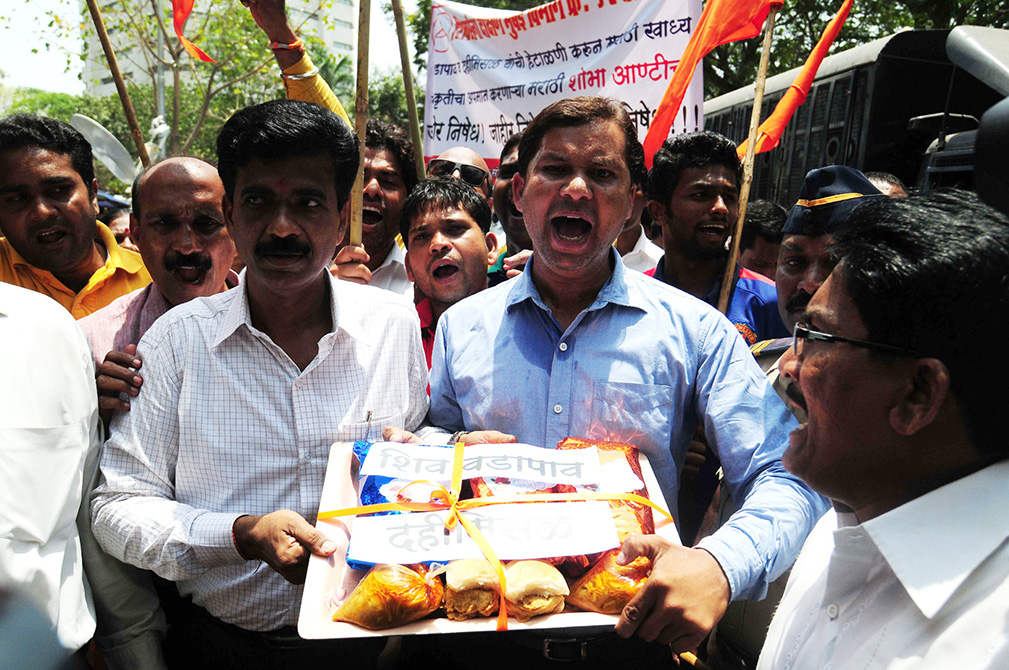The manufactured controversy around Shobhaa Dé's tweets reveals the extent to which the political discourse in Maharashtra has degenerated, says Thomas Crowley.
It pains me to say this, but I’m going to begin this column by defending Shobhaa Dé. The uproar about her Marathi cinema tweets has largely died down—although she still may face legal action—such is the nature of the 24-hour news cycle. But the issues Dé raised deserve attention and deeper analysis, especially because of their larger implications for culture and politics in Maharashtra and in India as a whole.
A brief recap, for those who didn’t follow the tamasha: the BJP-led state government in Maharashtra recently mandated that all multiplexes show at least one Marathi film during “primetime” hours. Following this, Dé sent out a series of sarcastic tweets, referring to the Chief Minister as Devendra ‘Diktatwala’ Fadnavis, labeling the move as “dadagiri”. and finally, ending with a joke: “No more popcorn at multiplexes in Mumbai? Dahi misal and vada pav only.”
The Saamna editorial took a predictably communal turn, stating, “Had Chhatrapati Shivaji, in his time, and Balasaheb Thackeray not done ‘dadagiri’, then your forefathers and her children would have been born in Pakistan and you would have been attending Page 3 parties in a burqa.”
Although De was protesting a BJP initiative, it was the Shiv Sena that took umbrage, defending the BJP CM and claiming that Dé was insulting Marathi culture. No matter that Dé has often expressed her appreciation of Marathi films and was only decrying their forced imposition. No matter that Dé is actually a Maharashtrian Hindu, and thus does not belong to any of the “outsider” (South Indians, North Indians, Muslims) categories that the Shiv Sena so often rails against in its divisive ethnic politics. Despite this, she still represents an “Other” that the Shiv Sena has conveniently targeted as a way to channel populist anger: she is English-speaking, absurdly wealthy, Westernised, and thoroughly devoted to upper-class gossip and fashion. So the Shiv Sena went on the attack, lambasting Dé in the party mouthpiece, Saamna, and organizing protests outside her house.
The forms of their attack were particularly telling. The Saamna editorial took a predictably communal turn, stating, “Had Chhatrapati Shivaji, in his time, and Balasaheb Thackeray not done ‘dadagiri’, then your forefathers and her children would have been born in Pakistan and you would have been attending Page 3 parties in a burqa.” This statement can’t be taken at face value, given its dubious historical claims, its convoluted logic, and its tenuous connection to Dé’s tweets. The barely hidden subtext of the editorial is clear—the manufactured controversy is being used to lash out against, on the one hand, vapid, elitist Bollywood culture, and on the other, the oft-demonised Muslim.
The protests outside Dé’s house showed a bit more creativity, but still missed the mark. Shiv Sena members presented her with plates of vada pav and dahi misal, which Dé cheekily accepted, clarifying yet again that she loves Marathi culture, just doesn’t want it shoved down her throat. There’s also the fact that vada pav, which has been embraced by the Shiv Sena in recent years, is an odd choice as a representative of age-old Marathi culture. The snack was, reportedly, invented in 1971; it’s younger than the Shiv Sena itself! And the word—and likely the baking technique—for “pav” comes from the Portuguese (“pão” simply means bread). In light of this, the Shiv Sena’s antics look a bit absurd.
And yet, one can understand the resentment towards a figure like Dé, who so clearly represents the economic and cultural elite of the city. There has been a long history of populist rhetoric targeting this elite, and at least some of this rhetoric has had a strong Left tinge. This is precisely why, in the 1950s, communist leaders supported the Samyukta Maharashtra Samiti (SMS), which pressed for a unified Marathi-speaking state. As the anthropologist Thomas Blom Hansen has noted, communists joined the movement because “the portrayal of the Gujarati, Parsi and Marwari communities as alien parasites appeared as anti-capitalism in new guises that depicted Bombay industrialists as antagonistic to the interests of the common people.”
This optimistic assessment of the movement was clearly misplaced, as history was to show. When Maharashtra was formed, the energy from the movement dissipated. And as the Shiv Sena rose in prominence, cashing in on the ethnic nationalism nurtured by the SMS, their first target was the communists, whose unions they weakened and whose leaders they killed.
The main threat to the Shiv Sena now comes not from the Left, but from the Right, as the BJP has co-opted their agenda and shown their power as a national party. Many interpret the Shiv Sena’s recent moves, such as an inflammatory call for Muslims’ voting rights to be revoked, as a way to regain attention and prove their relevance in an era of BJP dominance.
Communists joined the Samyukta Maharashtra Samiti because “the portrayal of the Gujarati, Parsi and Marwari communities as alien parasites appeared as anti-capitalism in new guises that depicted Bombay industrialists as antagonistic to the interests of the common people.”
Fine. The Shiv Sena has grabbed headlines by proclaiming Shobhaa Dé as their adversary. But, despite my sympathy for Dé in this case, I don’t want to be forced to choose a side in this fight. The two sides present a false binary, between the elitist, jet-setting superficial worldliness of Shobhaa Dé and the narrow, exclusionary, violent populism of the Shiv Sena. De is a self-proclaimed warrior in the fight against “parochial thinking”, but do we really want her kind of cosmopolitanism? In a recent interview, she claims she has the support of the “average, anonymous citizen of India,” and portrays herself as merely one citizen out of many standing up for her rights. The idea that someone as privileged as Shobhaa Dé speaks for the average citizen is laughable, and yet her rhetoric comes as no surprise. Elites like Dé are accustomed to assuming the role of the “aam aadmi” when it is rhetorically useful for them, eliding “public interest” with their particular class interest.
It’s unfortunate that we’re now faced with this false binary of Shobhaa vs. Sena, especially since Maharasthra has such a rich tradition of progressive thought and mass movements, from the militant labor movement in Bombay to the pioneering anti-caste struggles of Ambedkar. But both of these movements have been seriously weakened, as both mainstream communist parties and mainstream Dalit parties have taken a sharp rightward turn, which has become especially pronounced in the neoliberal era. The communist parties no longer have a strong presence in Mumbai at all, and the leading Ambedkarite party, the Republican Part of India (Athavale)—well, it was at Shobhaa De’s house too, delivering some misal pav. The party has aligned itself with the BJP, one of many signs of the Dalit movement’s rightward shift.
To its credit, though, the party has taken a bolder, more adversarial stand on an issue of food culture that is much more substantive the De’s vada pav tweets: the beef ban in Maharasthra. Shiv Sena has tried to make vada pav the true food of the aam aadmi. But if you really want to take about working-class food culture, talk about beef. As the cheapest meat, it is the most economical protein source for the poor. Further, beef has strong caste associations, as it is mostly eaten by Dalits, along with Muslims. The RPI(A) has opposed the beef ban, but has skirted around central issues of caste and class. Party leader Ramdas Athavale has simply given the anodyne argument that the ban will be bad for farmers, without emphasising that it will hit poor Dalits especially hard.
Athavale will go against his allies in the BJP by opposing the ban, but he will not question the fundamental logic of the BJP and its Sangh affiliates, which seek to draw the lower castes into the Hindutva project and to pit Dalits against Muslims, even though both these marginalised groups share many occupational and cultural practices. The communal riots in Uttar Pradesh in 2014, encouraged by the Sangh, were largely Dalit-Muslim conflicts. This strategy of communal polarisation paid dividends for the BJP; some have argued that it was the decisive factor in their 2014 election victory.
Athavale will go against his allies in the BJP by opposing the beef ban, but he will not question the fundamental logic of the BJP and its Sangh affiliates, which seek to draw the lower castes into the Hindutva project and to pit Dalits against Muslims.
These issues are particularly apposite given the recent celebrations of Ambedkar’s birthday, and the attempts by the BJP and the RSS to co-opt Ambedkar and portray him as a Hindu nationalist. Of course, this is patently false; Ambedkar was vehemently opposed to Hindutva. Many progressive commentators have already invoked his words in this regard, but they bear repeating: “If Hindu Raj does become a fact, it will, no doubt, be the greatest calamity for this country. No matter what the Hindus say, Hinduism is a menace to the liberty, equality and fraternity. On that account it is incompatible with democracy. Hindu Raj must be prevented at any cost.”
This clarity of purpose, this strength of conviction—this is sorely missing in the debates about Shobhaa Dé and vada pav, and even in the scattered opposition to the beef ban. In the home state of Ambedkar, the birthplace of the Dalit Panthers, the historic site of massive strikes, a return to radicalism is much needed.














